
Please send all Checks and Money orders to :
Dave Taylor P.O. Box 87 Sylvania, OH 43560
419-842-1863
Click Here to E-mail Us!
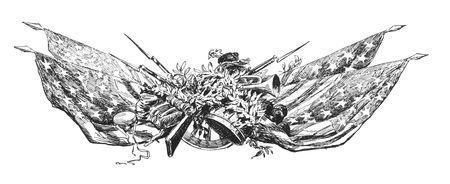
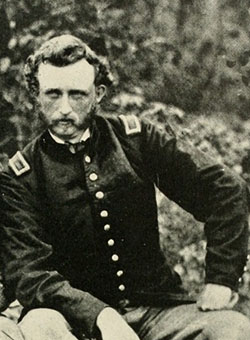
18-12-03
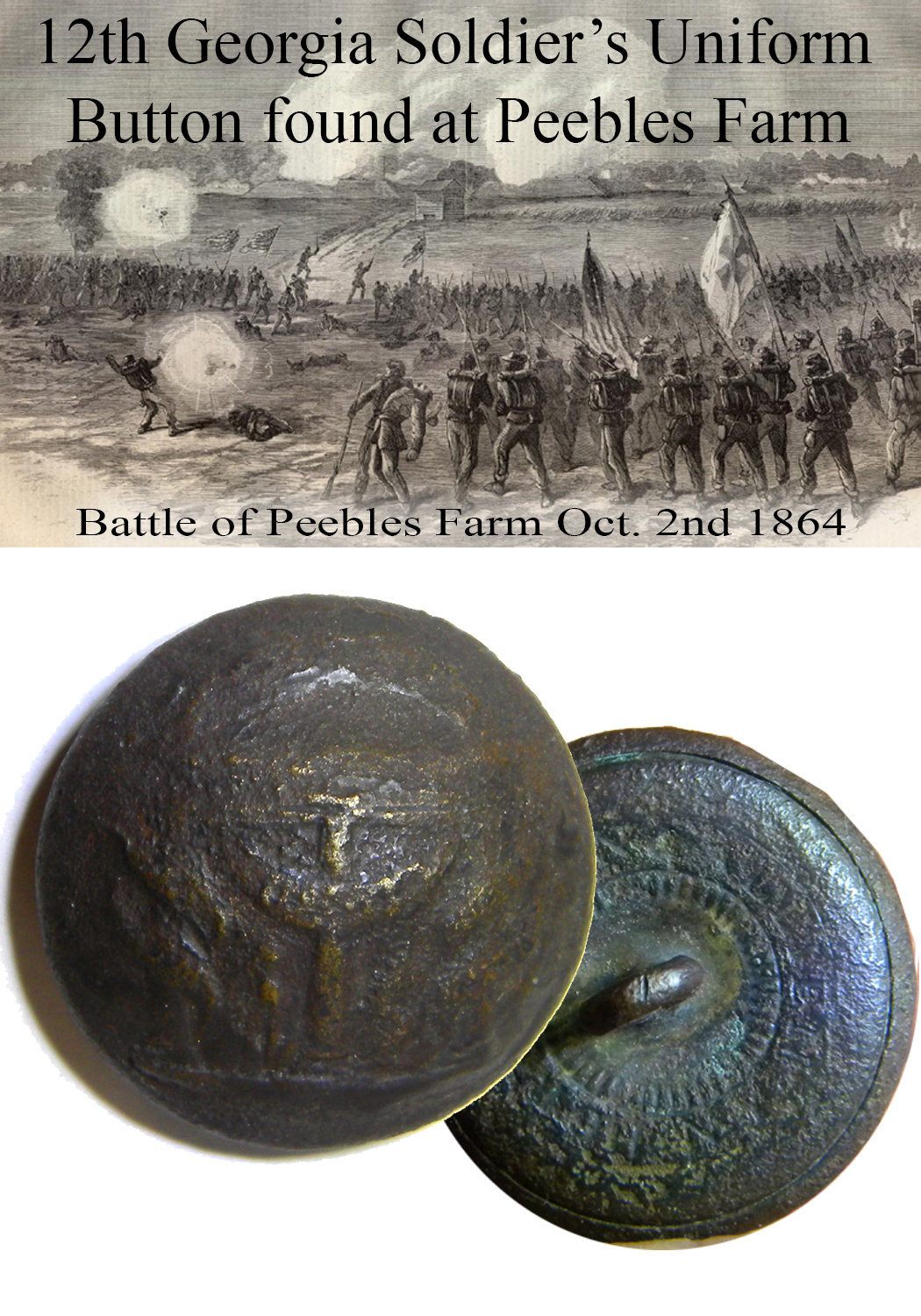
18-12-41…
MATTHEW BRADY 1861 CDV PHOTO ARMED FULL STANDING NEW YORK COLONEL CAPTURED AT HARPERS FERRY AND SERVICE DURING GETTYSBURG:
I just got this out of a New York auction last week. It is a nicely composed standing portrait of Col. William Green Ward commander of the 12th New Infantry. He served three separate terms in the regiment between 1861 and late 1863, being captured at Harpers Ferry on September 14th 1862. Ward and the regiment answered Lincoln’s first call for troops and served April through August 1861. They upped again in May of ’62, were captured at Harpers Ferry in September and declared exchanged in Jan. 1863. They were mustered out again. When Lee invaded Pennsylvania the 12th Regt. was called up once more and on June 18th 1863 left NY for Harrisburg, PA. with our Col. Ward in command again for 30 days service during the Gettysburg Emergency. Their final service was a couple counties north of Gettysburg in the Department of the Susquehanna under Gen. Yates. They must have done a real good job because Lee did not attack Harrisburg. Hurrah. Brady shows the colonel wearing regulation federal uniform and regulation M1850 sword. He also sports a fancy officer’s belt and and also the seldom seen baldric (shoulder belt) with fancy plate that I assume supports his sabertache (fancy brass bound cartridge box) on the other side. This photo was taken in 1861 as Ward’s rank is clearly Lieutenant Colonel. He was promoted full bird Colonel on May 31st 1862. Brady took at least two views when Ward visited his studio on this day in 1861. The Library of Congress has a companion Brady view to this image where our man is holding his cap in his hand. Overall very good with light age toning. Inscribed on the verso “Col. Ward / Col of 12th Reg’t Civil War” in 19th century pencil. I will include a laser print on photo paper, of the companion CDV owned by The Library of Congress. A fine, early war, Matthew Brady CDV likely taken by Brady himself when Lincoln was just beginning to realize how serious things were becoming. $265.00
sold
Call us @ 419-842-1863
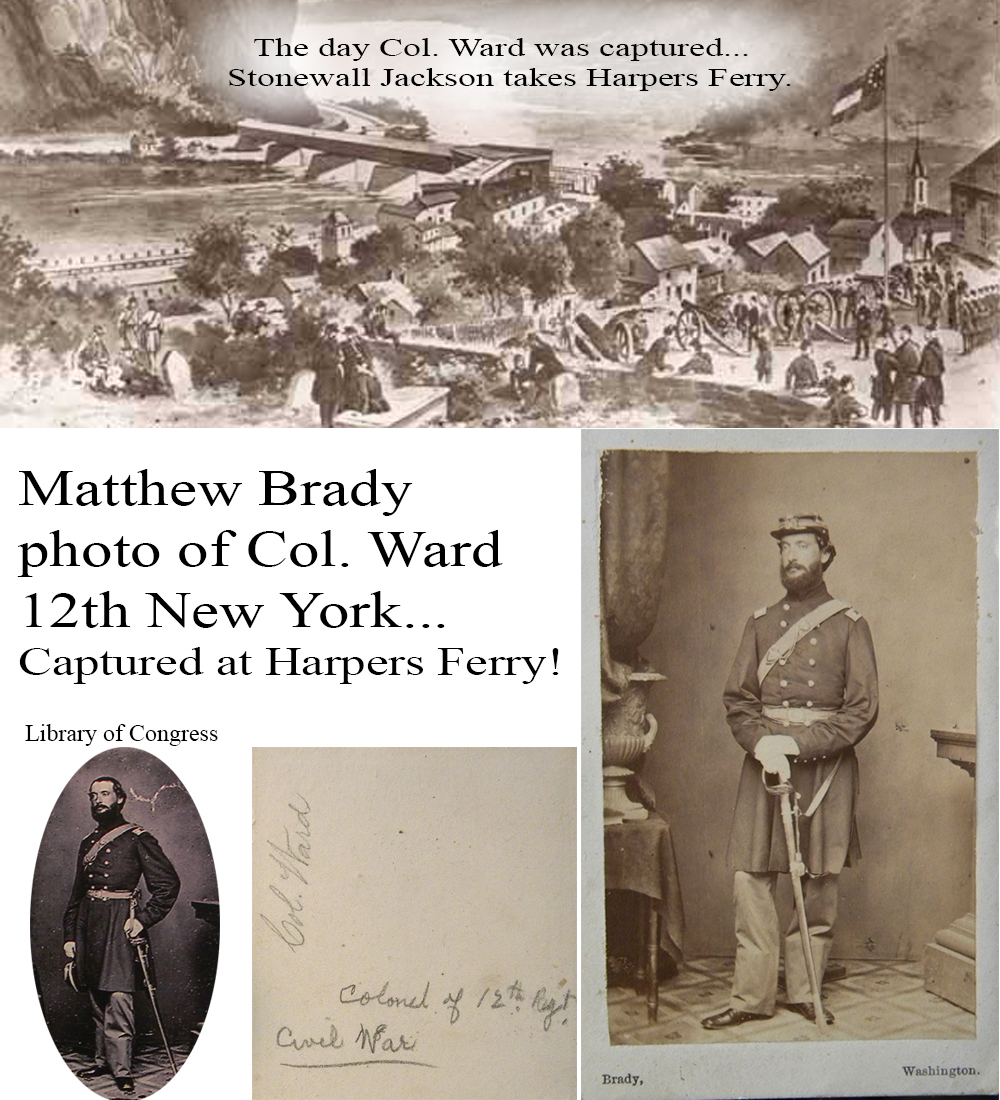
18-12-42… A BAD DAY ON THE BATTLEFIELD
seemed like the perfect title for this macabre military personal item. This is a classy silvered snuff box… slightly larger than 3 x 2 inches in size, and just under an inch deep. Excellent condition. Nicely marked
“Patent Jan. 24 1860 / C. Parker”.
The lid is nicely impressed with a gruesome battlefield scene. An exhausted, despondent, mustached officer is shown sitting on a pile of corpses, some partially buried, while he is resting his arm on a shovel handle. At his feet is a broken cannon. For some reason the artist has shown us an oarsman rowing a boat in the river, and depicts the sun rising behind a house across the river. Another small structure across the river looks like a small church with a cupola. Maybe the river is the River Styx and the oarsman is the boatman transporting the newly dead to hades… and yet the new day and Church are also present on the other side. Just a thought. On the bottom of the snuff box is an equally well executed impressed image of George Washington’s Tomb with an 1860s woman and child standing near the gate. I would love to find a period advertisement for this and see how the artwork was described and marketed. The officer on the lid is clearly not Washington. Why is Washington’s Tomb on the bottom? A great Civil War snuff box which I am pricing exactly what one sold for thirteen years ago at auction. Link to 2005 auction
276: Civil War Snuff Box on LiveAuctioneers ……. $275.00
sold
Call us @ 419-842-1863
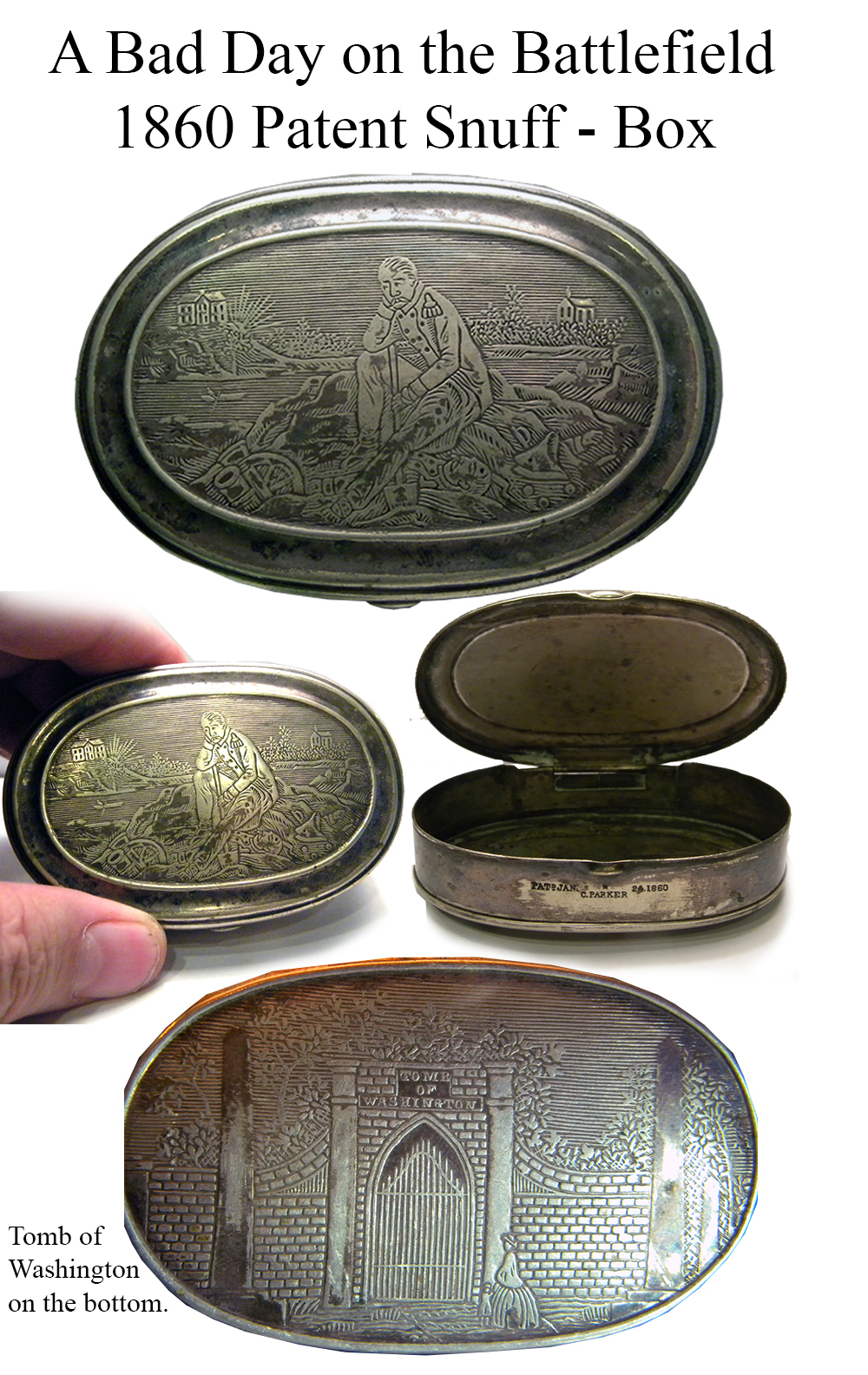
18-12-43…NEW ORLEANS / HYDE & GOODRICH MARKED HENRY DERINGER PISTOL:
A wonderful southern gun I just bought last Saturday at auction as I type this. This is a fine .45 caliber Henry Deringer Philadelphia percussion single shot pistol that is magically marked on the top of the barrel “MANU’d FOR HYDE & GOODRICH / AGENTS / N. ORLEANS”. The lock is deeply signed “DERINGER PHILADELa” The breech of the barrel is marked exactly the same, and the left barrel flat is stamped with a capital “P”. Hyde and Goodrich began in business in 1819 and went out of business in July 1861 when the war began. This silver mounted treasure is seven inches overall length, with a 3.5 inch barrel in .45 caliber. The wrist is inlaid with a monogrammed silver escutcheon shield engraved “J B C” … Script J on the left in small size, Script C on the right in small size, Script B in the middle in large size. Owner’s initials were J.C.B. The trigger guard, lock, hammer, breech plug tang, and escutcheon are all beautifully engraved. Condition is VG to near fine overall. The comical aspect to this pistol is that I bid on it without ever looking at it before hand. Earlier in the sale another dealer had commented on how nice all the Deringers were. I wasn’t especially looking to buy Deringers so I didn’t pay any attention to them. Then, while sitting in the audience and looking at my catalog, I saw that the next lot was a Deringer with the Hyde & Goodrich markings. Oh crap… I hadn’t looked at it. All I knew was that a guy I respected had commented hours ago about how nice all the Deringers were, so I bid on this thing trusting that the earlier comment I had heard was correct. When the auction girl brought me the gun, I breathed a sigh of relief and broke into a smile seeing that the marking was absolutely real, and that the gun was truly very nice. If you want to comparison shop check out this twin brother offered currently at $4,250 by my friends at Collectors Firearms in Houston…
Scarce Hyde and Goodrich Marked Henry Deringer Pistol (AH4525)
I will sell mine to you for… $2,750.00
sold
Call us @ 419-842-1863
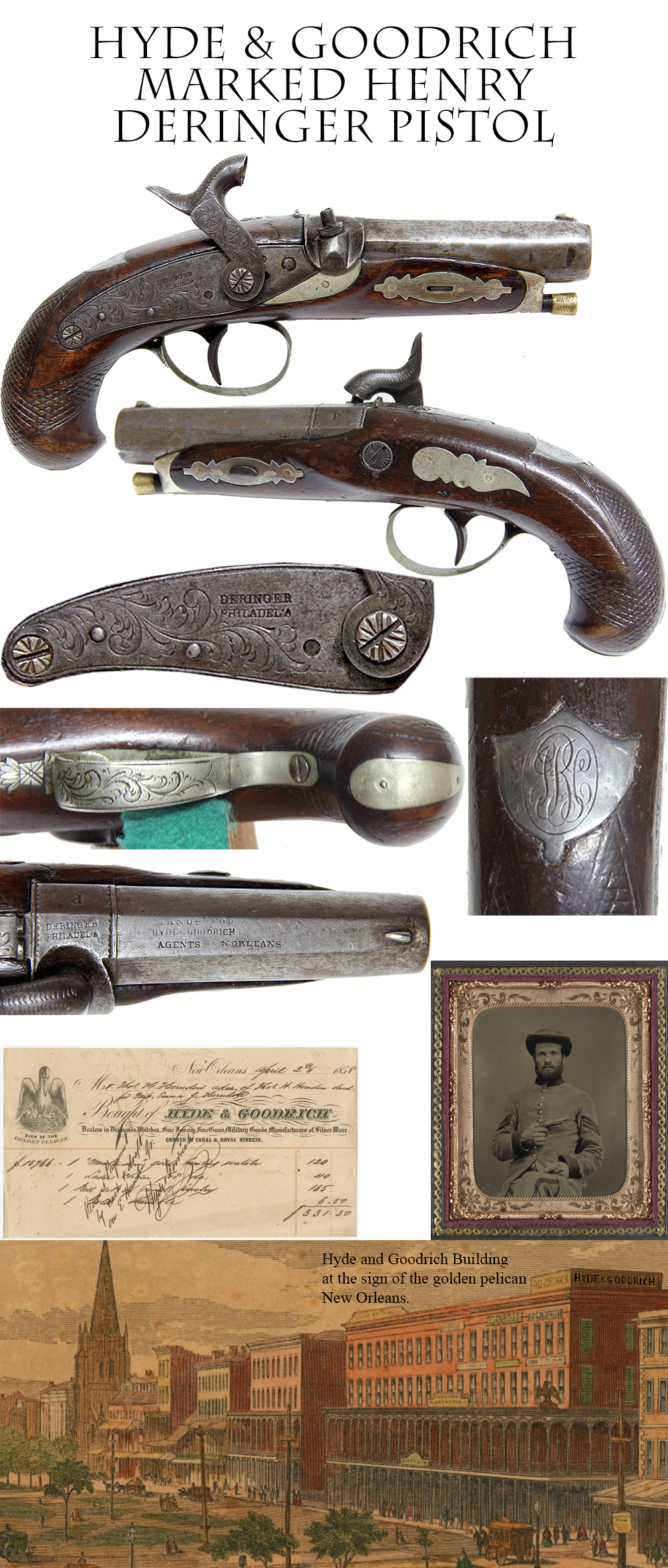
18-12-44…1860 DATED ROYAL ARTILLERY SERGEANT MAJOR’S POCKET TELESCOPE:
This is a very appealing military telescope, fresh from an antiques auction in New England. It measures just under 16 inches when fully extended, and just under 6 inches when closed. There is a sliding (retractable) sun shade around the objective lens. There is also a sliding lens shutter on the eyepiece lens. Engraved on the brass tube closest the eyepiece in attractive period script is “Battery Sergeant Major H. Harris R. A. 1860”. It is also engraved with the London Maker’s name of Joseph Somalvico & Co., a long standing London telescope and barometer maker, in business from the early 1700s well into late 1800s. I located the owner, Sergt. Harris, on the internet in the rosters of the English Royal Artillery, by doing numerous Google searches. He is carried on the rolls shown online in 1851, 1861, and 1871. He is career soldier, Hugh Harris listed as a gunner and driver in 1851 and listed as staff sergeant in 1861, and Battery Sergeant Major in 1871. I do not know the reason why the posted English records are 10 years apart in years ending in 1. It may hinge on when Harris first enlisted and the dates he re-upped. He served at least twenty years, the last ten as Battery Sergeant Major. The regiment saw service in Crimea in 1854, 55, and 56. I learned that around the year 1860 of the eight garrison artillery brigades, three were stationed in England while the remainder had their headquarters respectively at Gibraltar, Malta, Quebec, India, and Mauritius. I do not know in which brigade or battery Hugh Harris served. Each brigade was commanded by a colonel with an adjutant as staff officer. In 1860, the Armstrong rifled barrel gun replaced the smooth bore gun. At this time the entire regiment numbered 747 men of whom 714 were admitted to the hospitals during 1860. Regimental strength declined for several years thereafter. I will leave the rest of the research to you. The telescope is in excellent condition overall. The optics function, and it is of very good quality. With the 1860 date, it is certainly appropriate for display with Union or Confederate Army officers effects. If you have access to English military records you may find a wealth of additional information. I’ve been patting myself on the back for the history I’ve uncovered so far. $465.00
Call us @ 419-842-1863

18-12-45…CO. “C” 101st REGT INSCRIBED POWDER FLASK:
This handsome Colt style powder flask was manufactured for use with a 31 caliber revolver, such as the Colt pocket model. What makes it unique, is the incised inscription on the front and back. One side has the owners initials “J*M”. The other side reads “Co. C. 101. REGT”. Absolutely and unquestionably incised during the Civil War and very artistically rendered using “folky” double incised lines. There were only five states, and one USCT, that fielded regiments designated as 101st. USCT, Illinois, Indiana, New York, Ohio, and Pennsylvania… take your pick. Too bad the soldier didn’t include his last name. Overall very good condition. $325.00
sold
Call us @ 419-842-1863

18-12-46….WORLD WAR TWO GARAND BAYONET:
A top shelf specimen complete with the scabbard. Signed “AFH 1943” and bears the ordnance bomb mark and US. The green fiber scabbard has the ordnance bomb and US stamp on the throat. Blade is 9 7/8 inches… overall length of bayonet is 14 1/2 inches. Looks like eBay knocks these down in this condition in the $150 to $200 range. I’ll take. $135.00
sold
Call us @ 419-842-1863
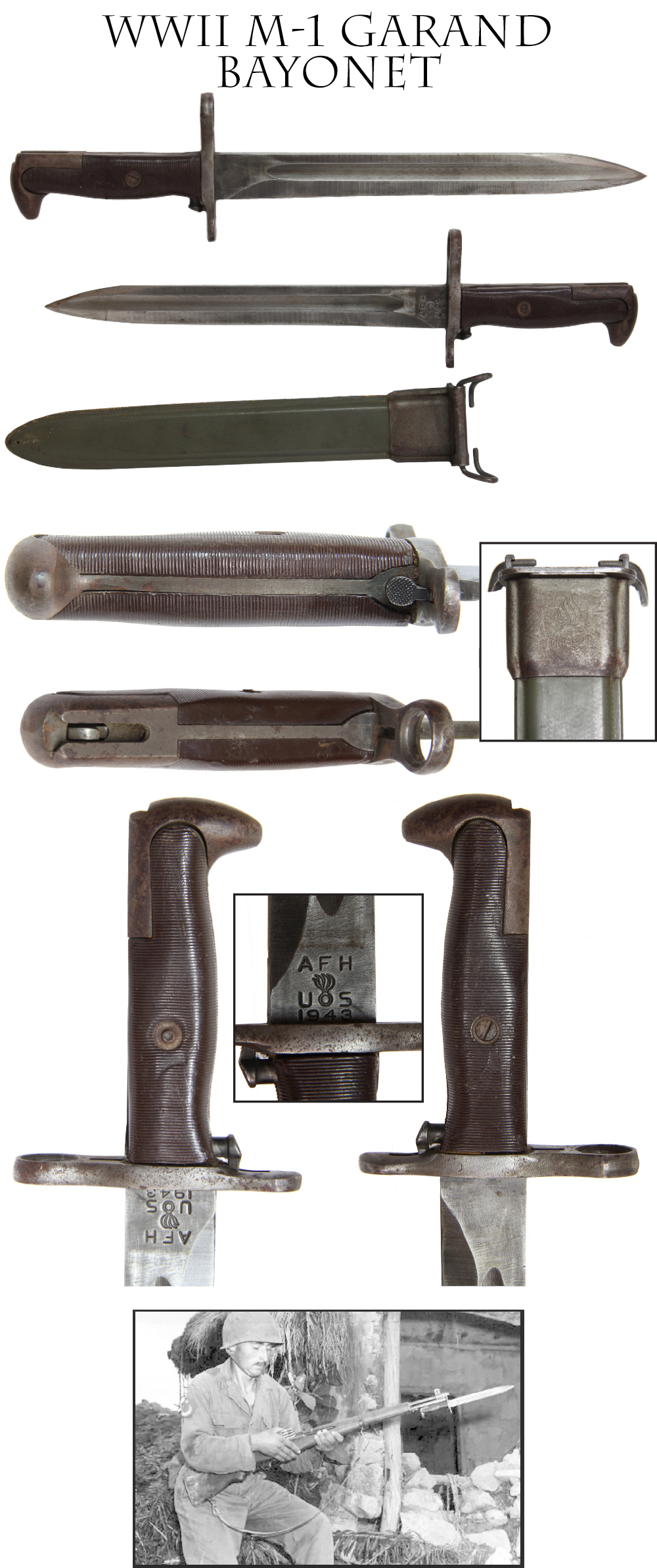
18-12-47..VERY SCARCE MANUAL / THE FIELD MANUAL FOR BATTALION DRILL by Coppee of The USMA:
Excellent condition pocket size manual for a combat officer or NCO. Published by Lippincott in Philadelphia in 1862. 152 pages. Fine green cloth over board covers embossed with an eagle and shield. Title in gilt on spine. Inside of the front cover has remnants of a man’s old library paper label…” B. Franklin Coo….”. Read this manual carefully and you’ll learn how to lead a couple hundred men into battle and whip General Lee. $240.00
sold
Call us @ 419-842-1863
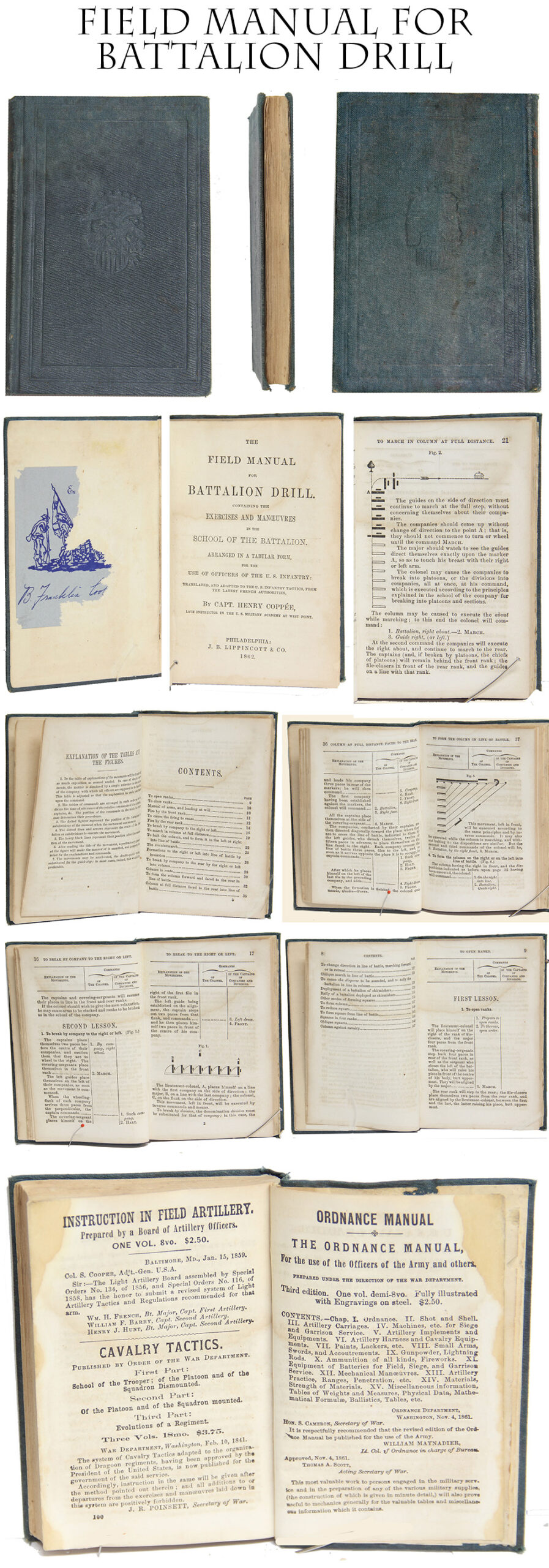
18-12-48…CIVIL WAR PRODUCTION SMITH AND WESSON .22 CALIBER MODEL 1 REVOLVER AND A CDV OF A MAN HOLDING ONE:
These rimfire seven shooters were extremely popular self protection weapons during the Civil War. Serial # 25243 tells us this was produced early in the production run which began in 1857. It was likely made just before the Civil War or in the early months of the war. 100% original 100% complete and mechanically functional. Overall plum patina on the steel. The frame and straps retain most of their silver wash. There is a professional repair at the toe of the rosewood grip, otherwise no repairs. Here is Mark Twain’s story about his experience with the little S&W… He wrote: “I was armed to the teeth with a pitiful little Smith & Wesson’s seven-shooter, which carried a ball like a homopathic pill, and it took the whole seven to make a dose for an adult. But I thought it was grand. It appeared to me to be a dangerous weapon. It had only one fault–you could not hit anything with it. One of our ‘conductors’ practiced awhile on a cow with it, and as long as she stood still and behaved herself she was safe; but as soon as she went to moving about, and he got to shooting at other things, she came to grief.” –
Roughing It. Also
included in this lot is a fine Civil War date original CDV photo of a Rhode Island gentleman holding precisely one of these guns
. Photo bears a Providence Rhode Island imprint.
Gun and CDV together … $395.00
sold
Call us @ 419-842-1863

18-12-49…NEAR PERFECT EXCAVATED “DUG” US BUCKLE:
The condition on this one is about as nice as you are going to find. When I was a kid the relic diggers found these super nice condition buckles all the time. Sometimes several in one day. Now they are nearly impossible to find in the camps and on the battlefields, even with the new metal detectors. This has the full lead solder filled back with both arrow hooks and the prong firmly in place and solid. This die strike is well known to collectors. The style and construction are so similar to the rare PHG buckles (Philadelphia Home Guard), that I personally believe both plates were produced by the same maker. I do not know where this plate was excavated. It came out of an ages old collection. $225.00
sold
Call us @ 419-842-1863
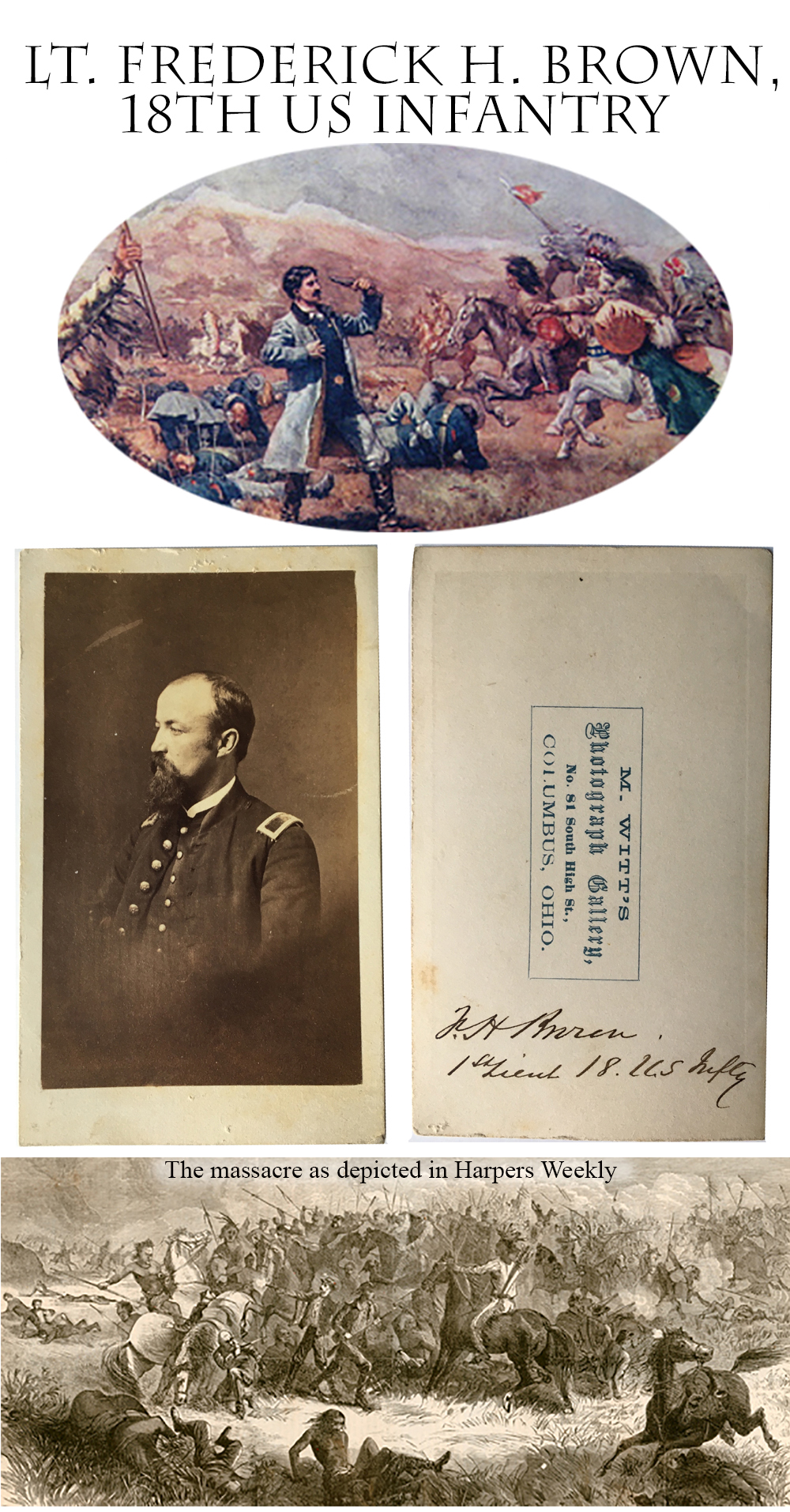
18-12-50 CDV OF INDIAN FIGHTER KILLED AT THE FETTERMAN MASSACRE IN THE COMPANY OF FETTERMAN HIMSELF:
A truly fine and historic photo of Lt. Frederick H. Brown, 18th US Infantry, one of three officers killed in the Fetterman Massacre of 21 December 1866 near Fort Phil Kearney. Wonderful tonal quality and clarity. Two light curved rubs to upper left and lower right of the figure. M. Witts Photograph Gallery, No. 81 South High St., Columbus, Ohio” backmark. Has a superb brown ink inscription on the back… “F.H. Brown / 1st Lieut. 18. U.S Infty”. Brown was from New York and enlisted in the 18th US Infantry as a private and then QM Sergt 18 July 1861; 2nd Lt. 30 Oct. 1861; 1st Lt 24 Mar 1862; Regimental QM 4 Nov 1861 to 15 May 1866. Capt. 15 May 1866. Brevet Capt. 1 Sept 1864 for gallant and meritorious service in the Atlanta Campaign. In the winter of 1866 Captain Brown was set to leave Fort Phil Kearney, but decided on December 21st to join Capt. William Fetterman’s command going to the relief of a wood cutting detail that had been attacked by Indians. Brown wanted to get one last crack at the savages. The entire detachment, 81 officers and enlisted men, and two civilians, were all brutally killed. The savagery of this fight is now seen as a harbinger of the gruesome Custer massacre of 1876. Col. Carringtons report on the battle mentions specifically that
Brown and Fetterman
certainly killed one another in the final moments of the battle: ”
Nearly all were heaped near four rocks at the point nearest the Fort, these rocks enclosing a space about six feet square, having been the last refuge for defense. Here were also a few unexpended rounds of Spencer cartridge. Fetterman and Brown had each a revolver shot in the left temple. As Brown always declared he would reserve a shot for himself as a last resort, so I am convinced that these two brave men fell, each by the others hand, rather than undergo the slow torture inflicted upon others.”
Looking at the Harpers Weekly illustration there is a soldier with a shaved head firing a pistol. We know that Custer had his hair cropped very short just prior to Little Big Horn. Looking at our photo of Captain Brown I can’t help but wonder if his bald pate and ultra short surrounding hair might not simply be a practical and intentional deterrent to bloodthirsty Red Savages bent on taking a scalp. Over twelve years ago (May 2006) Cowan’s Auction in Cinti. sold a differently posed CDV of Brown for $1,920.00. That carte appears to have been taken by the same photographer on the same day as our example. Link to $1,920.00 Cowan sale
CDV of Captain Frederick H. Brown, 18th US Infantry,
, In 2018 you can buy this one from us for $1,250.00
sold
Call us @ 419-842-1863
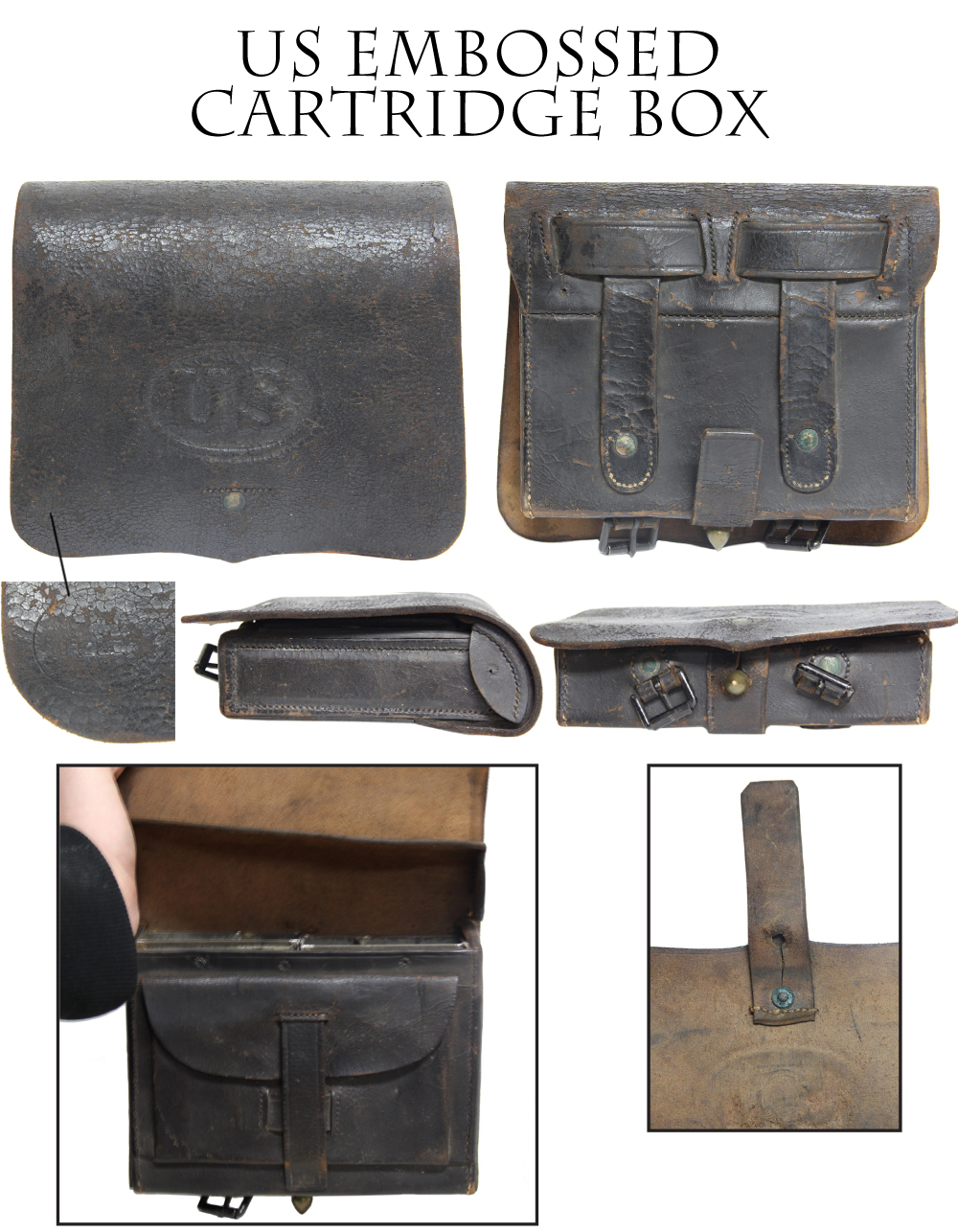
18-12-51…COMPLETE UNION INFANTRY CARTRIDGE BOX:
Known as the pattern of July 1864, Type 2, this cartridge box features the letters “US” within an oval border embossed upon the outer flap in the same size and style as the brass plate it replaced from earlier models. Exterior of this cartridge box features a pleasing surface of black bridle leather in very strong condition. Very light surface crazing is evident overall. . The leather latch tab is strong and intact. Both original black-japanned roller buckles are tightly sewn and riveted to the box bottom and are in excellent condition. Backside of box has the two leather belt loops that are stitched and riveted, along with the sling billets, all in excellent condition. Interior of box is excellent with strong inner flap, complete tool pouch and tab. Retains both tin liners. The right “side ear” on the interior half moon flap was missing so I had helper Chuck make a replacement. Otherwise 100% original and complete and very solid. Much better than average…. $375.00
Needs review
Call us @ 419-842-1863
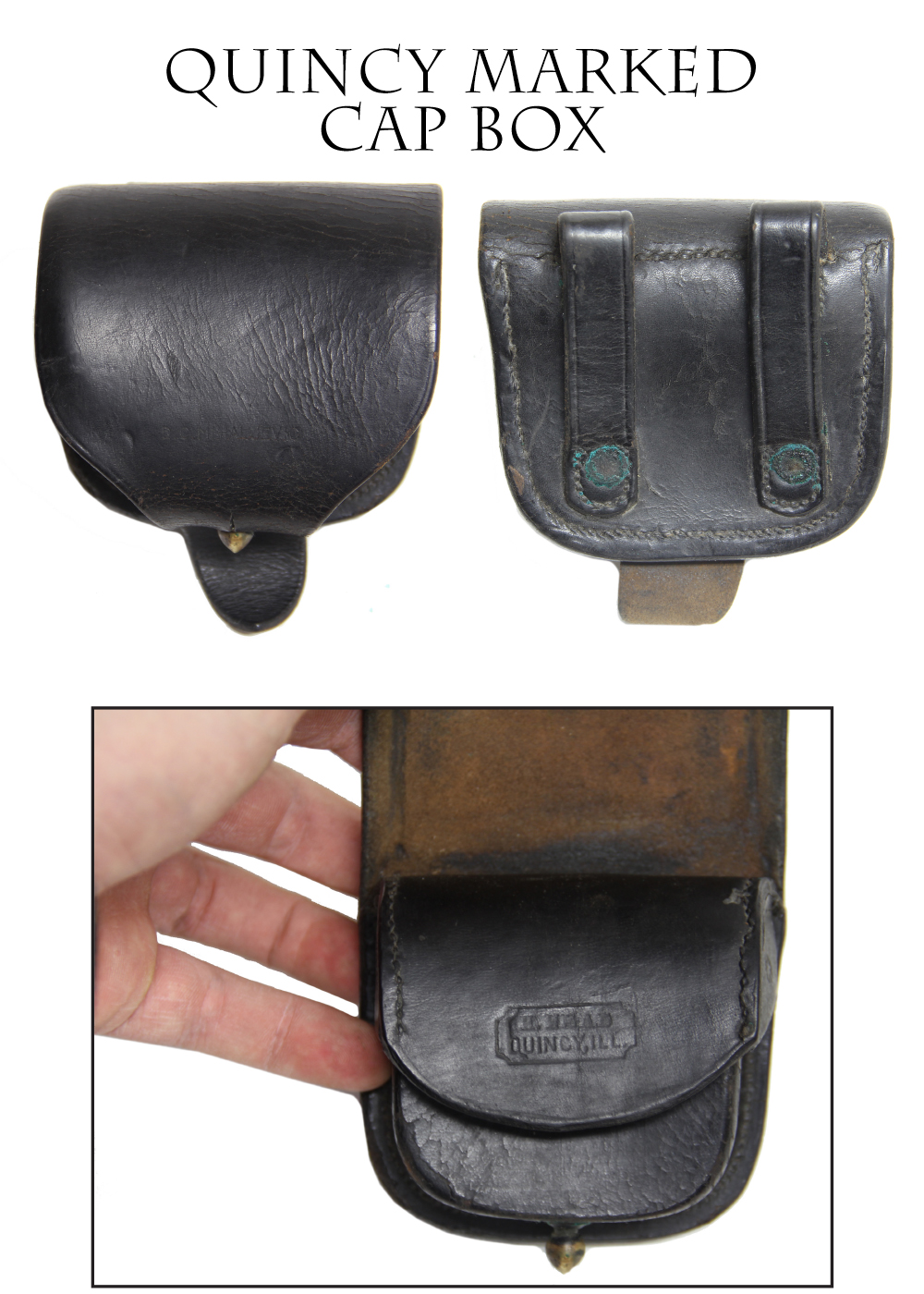
18-12-52…EXTREMELY SCARCE H. HEAD, QUINCY ILLINOIS CAP BOX….
Regulation Civil War issue cap box by one of the scarcest makers. These are extremely rare, but I acquired several by this maker from the estate of a good friend who liked Illinois material and spent a lifetime collecting it. He bought every piece of Illinois marked leather he could find. His son sold me around a dozen of the best examples… his dad had 40+ years of collecting involved in the accumulation. Don’t think they are common just because a few are suddenly available at once in my stock. Cap boxes were needed by every soldier armed with a percussion weapon and were made by a wide variety of contractors and arsenals in several different configurations. Among Civil War collectors they are collecting field in themselves. This one is in great condition, with good finish, just some crackling overall to the exterior and minor abrasion to the belt loops and high spots. belt loops and stitching in place and a deep maker stamp on the inner flap reading: “H. Head Quincy, Ill.” Henry Head was a saddle and harness maker who obtained government contracts for .58 caliber and .69 caliber accoutrements deliverable to the St. Louis Arsenal, as well as 1864 pattern accoutrement sets, bridles and halters. A nice example by a very scarce maker. $275.00 sold
Needs review
Call us @ 419-842-1863
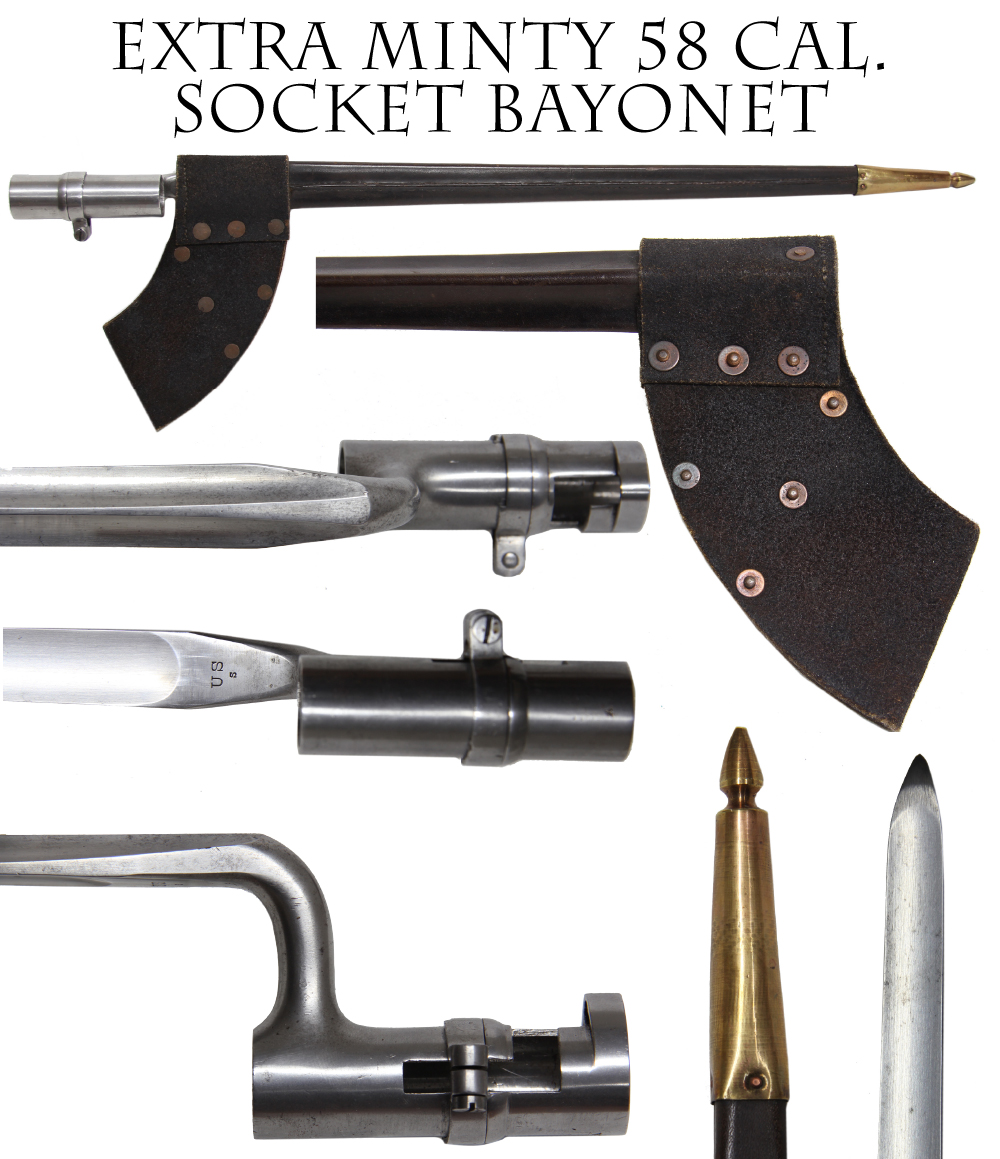
18-12-53…Near Mint CW Springfield Bayonet and Scabbard with Buff Frog:
Superb condition overall. Super scabbard with ultra desirable buff leather frog is 98.5% of the way to mint… just a couple surface scuffs on the body of the scabbard. Bayonet is bright and shiny. This rig would match a $2,500 to $5,000 musket. The US stamp is present on the blade as well as the inspector’s initials… “S” on the ricasso and “A” on the socket. Finding examples as nice as this was easy in the 1970s… not so today. This is about as fine an example as you are going to find. $465.00 sold
Call us @ 419-842-1863
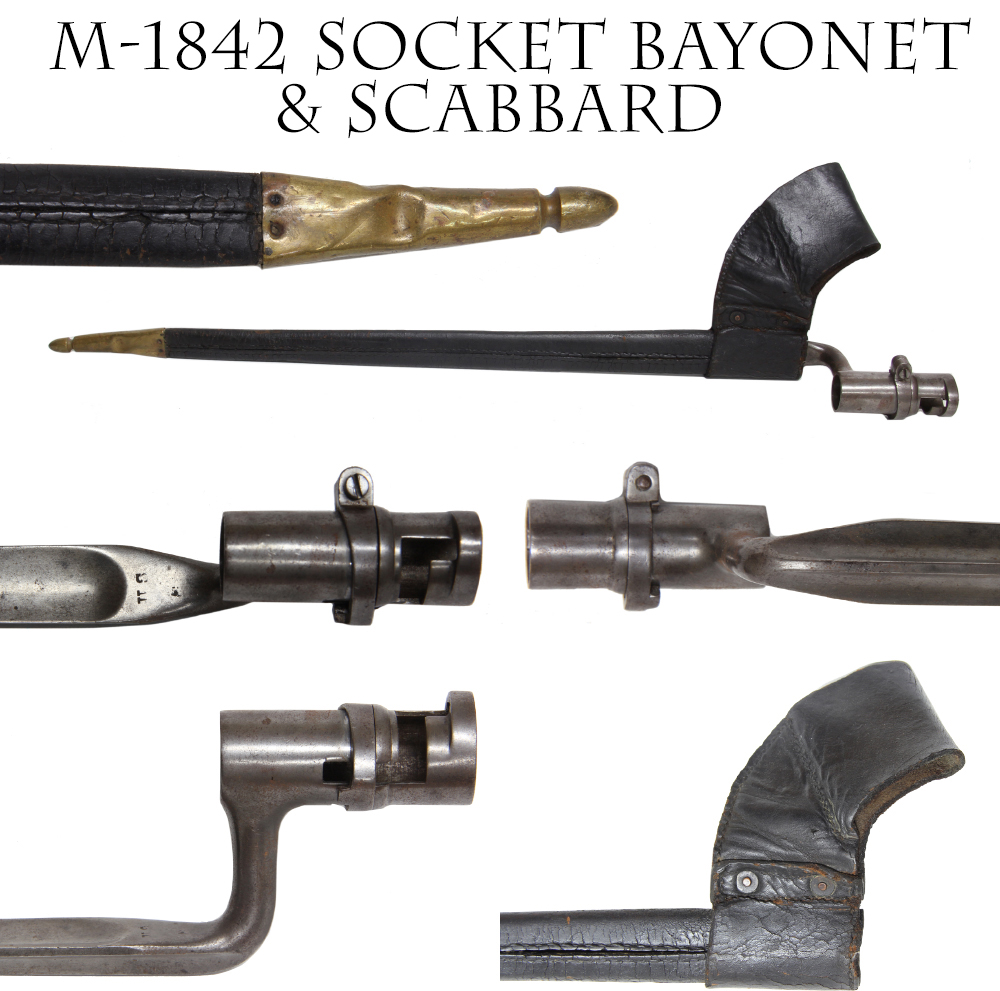
18-12-54…. Civil War Production M-1842 Socket Bayonet & Scabbard:
These rounded shoulder .69 caliber bayonets were made during the 1860s for use with the 1835 and 1842 muskets still in service. They are quite a bit scarcer than the squared shoulder examples produced two decades earlier. Both the bayonet and scabbard are overall VG to near Fine condition. The scabbard is the proper 2 rivet style for the M-1842 and it is complete all the way down to the brass scabbard tip. Bayonet is overall smooth steel with pleasant grey patina. US marking very visible with the bottoms of the letters being less distinct. If you have a Civil War used M-1842 musket, here is your bayonet. $395.00 sold
Call us @ 419-842-1863
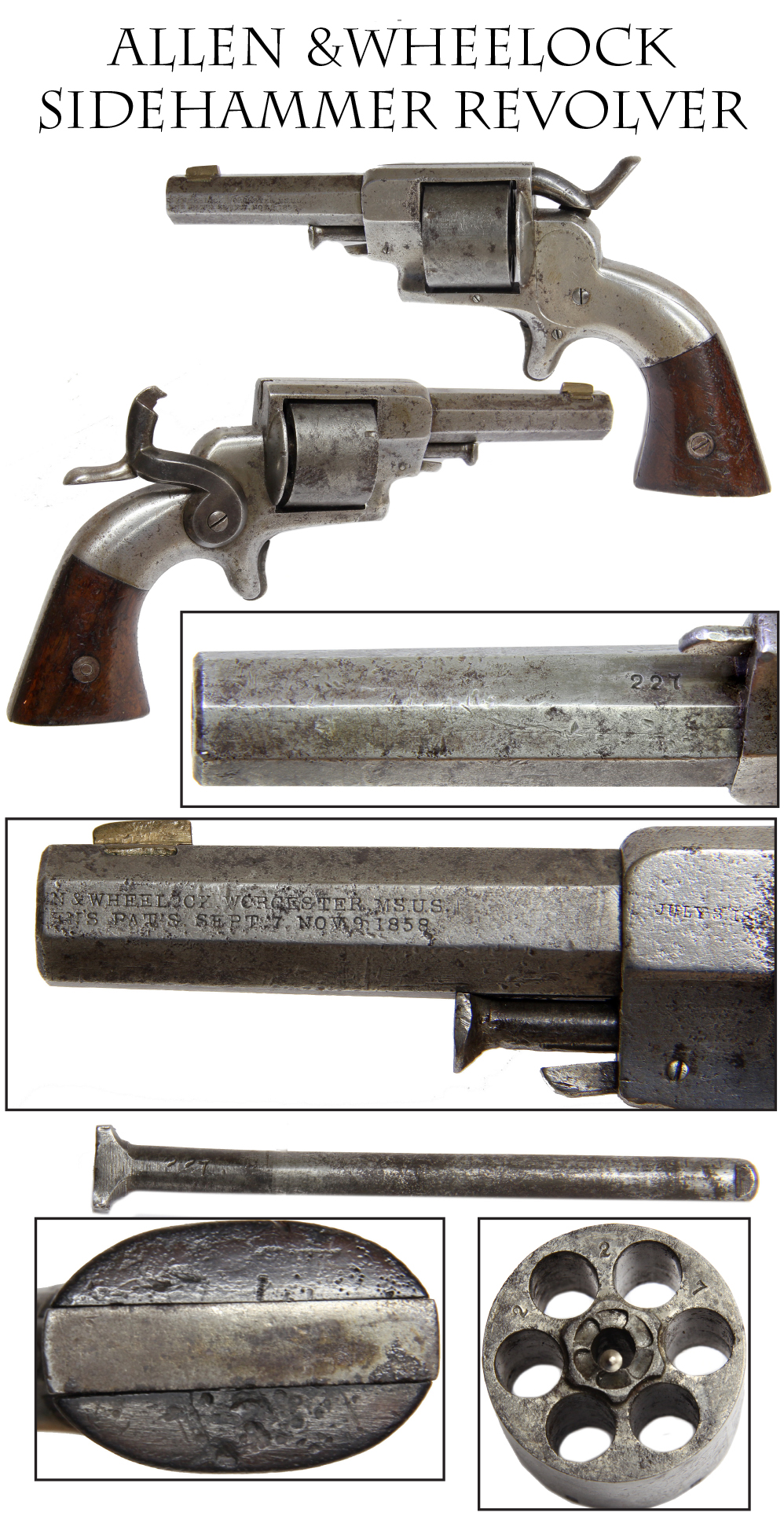
18-12-55… ALLEN & WHEELOCK SIDEHMAMMER .32 CALIBER REVOLVER SHORTENED TO 3 INCH BARREL …
The company turned out about 1,500 of these handy rimfire revolvers from 1858-1865 in at least eight variations. This one is numbered 227 on the barrel and cylinder. The two-line Wheelock patent stamp on the barrel flat is truncated indicating the barrel was shortened during its period of use and the long brass blade front sight installed, The July 3, 1860 patent date on the frame forward of the cylinder is partially visible, the section closest to the cylinder suffering from some firing corrosion. Mechanics are good. It cocks well. The cylinder advances when it feels like it. Front entry cylinder pin as is correct for the fourth and later types. Grips are good and tight to the metal, just some dings and divots on the butt. Some case color to the hammer. The frame and cylinder are gray mixed with dark gray and some brown spots. Some light pitting to the cylinder and on left of barrel and frame just forward of the cylinder. I listed this last week at $75 over my cost of $400… ($475) No Takers…. OK how about…..?? $420.00
Call us @ 419-842-1863

18-12-56… LONDON MARKED SCREW BARREL POCKET OR MUFF PISTOL:
These small turn-off barrel pistols were the derringers of their day. Easily concealed and carried in a pocket, or muff, they also provided a back-up weapon in a close fight, as Stephen Decatur testified. Provided with a fairly large bore, the screw-on barrel was even more important in that it allowed for a very tight fitting ball. This one has a less than 3 inch barrel, the underside of which shows a worn lug that was used with a barrel wrench to tighten or remove the barrel. The underside of the barrel shows two proof marks. The hammer is center hung (box lock) and there is a top mounted sliding safety, which along with the flat grips and reinforced hammer suggest a date in the 1820s. The frame is decorated with floral scrollwork and an oval cartouche on one side with London in the middle, and on the other with some cursory martial motif and the maker or dealer name Branch in the oval panel. The grips fit tightly with very little shrinkage and a few divots on the upper right. The best part in some ways is the folding trigger on this pistol, which along with the safety shows it is intended to be carried loaded in a pocket. 200 years old and still with us. I listed this last week at 575.00 without luck… Merry Christmas at $495.00
Call us @ 419-842-1863
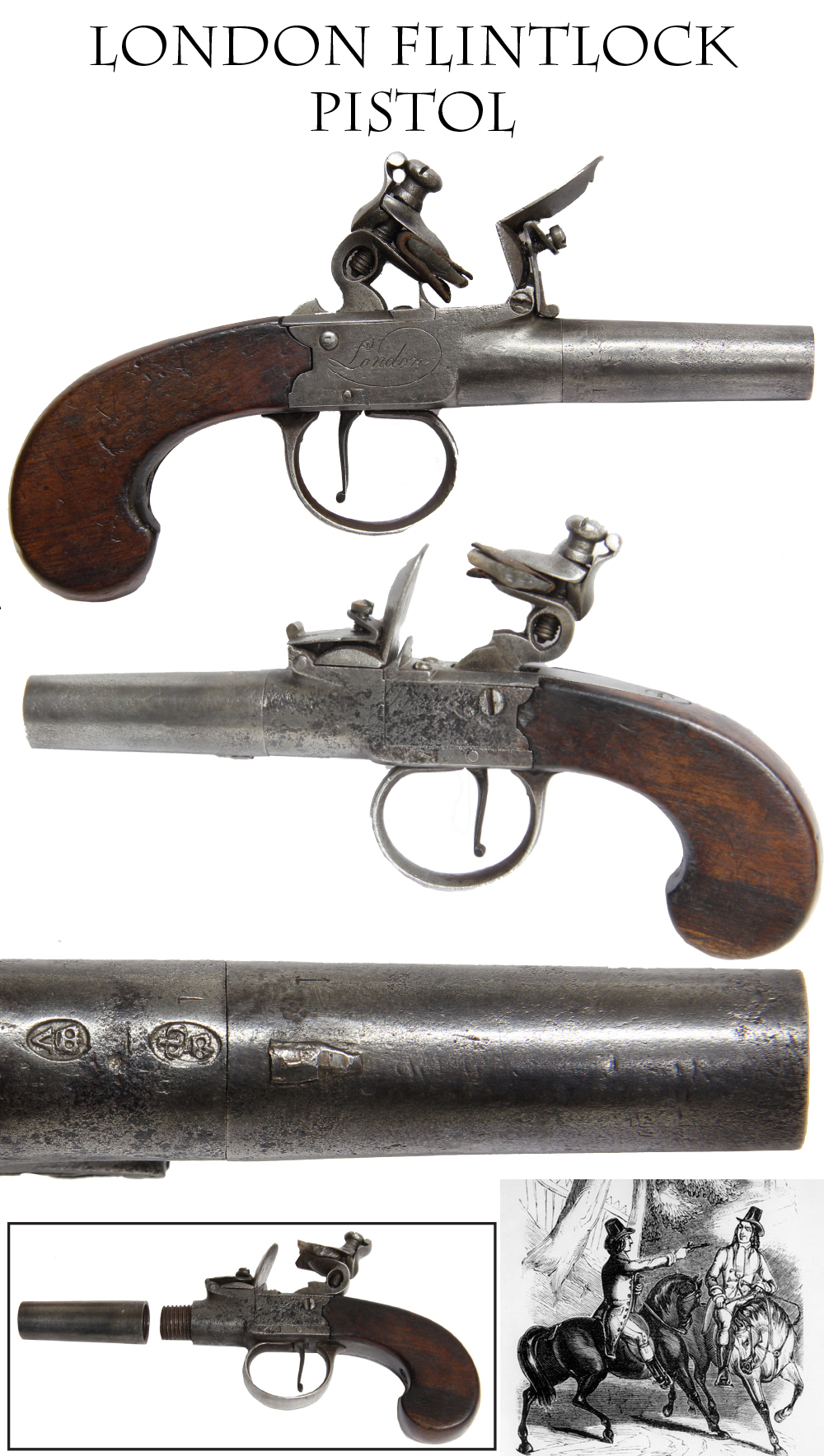
18-12-57…LONDON FLINTLOCK MUFF PISTOL …
Here is an even simpler version of the turn-off pocket pistol. This is provided with a conventional trigger, though guarded with a large triggerguard to avoid accidents in getting it out of ones pocket. Barrel lug is present, though as usual, worn. The two proof marks are visible on the underside of the barrel. The mechanism is functional the grips are plain and flat sided. Metal was cleaned some time ago. Barrel is smooth. Right side of frame shows some light pitting along the edge of the flash pan, but a clear London address on the right of the frame in a simple loop/flourish. The left side of the frame shows heavier pitting that obscures the script maker or retailer name. The wood is good, with just a few light dings and handling marks, one check on the forward left side, and narrow shrinkage gaps. A good example of the gentlemans overcoat or pocket pistol, though as mentioned with other examples of this gun, there is a reference to Stephen Decatur drawing a small pistol from his pocket to shoot an assailant during a naval boarding action. I listed this last week at 575.00 without luck… Merry Christmas at $495.00
Call us @ 419-842-1863
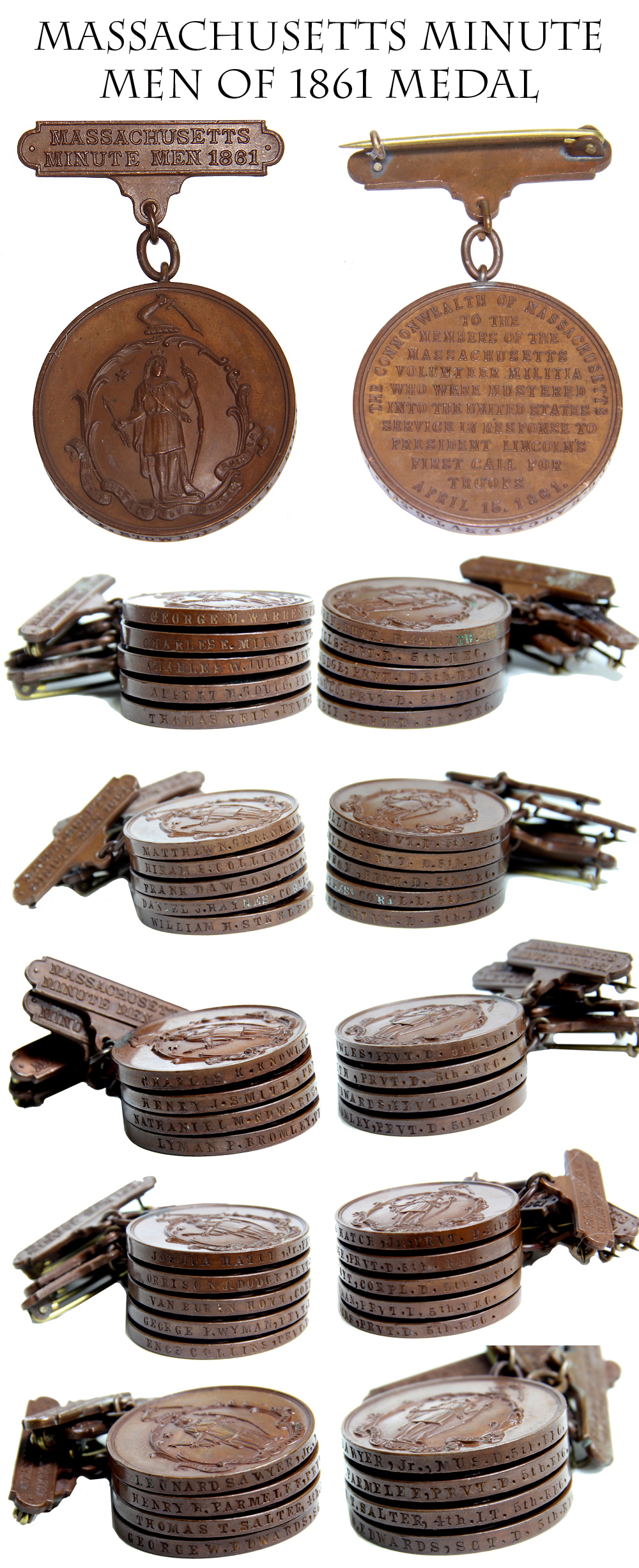
18-12-58… MASSACHUSETTS MINUTE MAN MEDALS FOR THE FIFTH MASSACHUSETTS:
VETERANS OF FIRST BULL RUN The State of Massachusetts authorized medals for those rare first responders who had answered Lincolns first call for volunteer troops to serve three months in April 1861. No other soldiers were authorized to have these. The bronze suspension bar reads Massachusetts Minute Men 1861 and the medallion has the state seal on one side and on the other the dedication, “The commonwealth of Massachusetts to the members of the Massachusetts Militia who were mustered into the United States service in response to President Lincoln’s first call for troops-April 15, 1861.” The medals were then struck along the rim with the soldiers name and unit. Somewhere between 3,000 and 4,000 of these medals seem to have been made for those early war veterans. Two brothers from California discovered a cache of these medals jn the rafters of their late fathers house, which had previously been the residence of one of the commanders of the Fifth Massachusetts. When found, these medals were still in their original cardboard boxes, but the boxes had sustained significant water damage and the brothers elected to discard them. Oh well. The brothers kept a couple of the medals and I bought the remainder. I had to pay dearly to get them but felt the find was significant. Most of these were awarded to members of Company D of the 5 th Mass. and came from the town of Haverhill. The regiment entrained for Washington April 21, 1861, and mustered into Federal service there on May 1. In July it was part of Franklins Brigade of Heintzelmans Division and fought at Bull Run, losing 9 killed, 2 wounded, and 23 captured. It returned to Washington and then to Boston, where it mustered out July 31. Many of the veterans then went on to serve in other Massachusetts volunteer regiments. I can offer the medals awarded to the following members of the Fifth Massachusetts. Unless otherwise noted, they were serving in the regiment during the period of First Bull Run.
*2* LEONARD SAWYER Jr. MUS
Sawyer must have had some musical talent. He was a 25 year-old shoemaker in Haverhill when enlisted as a musician on 4/16/61 and mustered into Co. D on 5/1/61. He mustered out on 7/31/61. He then enlisted again on 2/26/62 in the 17th Massachusetts as Principle Musician, serving until his discharge for disability on 9/30/62. The 17th was a three-year outfit that took part in Burnside’s Coastal Expedition. During Sawyer’s time with the outfit, they did duty at New Bern as part of Foster’s Division and took part in small raids, scouting, foraging, and outpost duty, losing two killed at New Bern on 5/22/62…. $350.00 less 10%
Call us @ 419-842-1863
*4* GEORGE P. WYMAN
Wyman is not listed with any profession, but was 21 and a resident of Haverhill when he enlisted on 4/16/61 and mustered into Co. D of the 5th Mass on 5/1/61. He survived to muster out with the regiment on 7/31/61 in Boston. $295.00 less 10%
Call us @ 419-842-1863
*7*
ORRISON J. DODGE KILLED IN ACTION AT MALVERN HILL
Dodge was an expressman in Haverhill and 23 years-old on 4/16/61, when he enlisted as a private and mustered into Co. D of the 5th on 5/1/61. He mustered out with the regiment on 7/31/61. Like Thomas Salter he reenlisted in the 22nd Massachusetts, enlisting and mustering in to Co. K as a sergeant to date 10/5/61 and becoming First Sergeant on 5/1/62. Like Salter, he became a sacrifice for the country. Where Salter was killed in the first of the Seven Days Battles, Dodge was killed in the last, falling at Malvern Hill on 7/1/62, the last of the engagements of McClellan’s withdrawal down the Peninsula, which he called a strategic “Change of Base,” but most regarded as a simple retreat. KIA $525.00 less 10%
Call us @ 419-842-1863
*8* HENRY J. SMITH
Smith was a 23 year old resident of Haverhill when he enlisted as a private on 4/16/61 and mustered into Co. D on 5/1/61. He served with the regiment until muser out on 7/31/61 at Boston. $295.00 less 10%
Call us @ 419-842-1863
*9* LYMAN P. BROMLEY
Bromley was a hatter in Haverhill. He enlisted 4/16/61 as a private and mustered into Co. D on 5/1/61 and mustered out 7/31/61. He enlisted again in the 17th Mass, like Leonard Sawyer, mustering in to Co. G. on 8/13/62, with whom he served until being discharged for disability on 2/12/63. He then tried his luck again in 1864, mustering in to Co. G of the 4th Mass Cavalry, but never left the state, dying of disease in Haverhill on 3/16/64. $325.00 less 10%
Call us @ 419-842-1863
*11* HENRY H. PARMELEE DIED OF WOUNDS
Parmelee or Parmlee, was a married paper hanger in Haverhill. Standing 5 foot 5 inches, with brown hair and blue eyes, he enlisted in Co. D of the 5th Mass on 4/16/61 and mustered into Co. D on 5/1/61. He mustered out 7/31/61, and then reenlisted in Co. M of the 1st Mass. Heavy Artillery on 3/1/62 as corporal, making sergeant in October. The regiment spent its early service in and around Washington. In the Spring of 1864, however, it was one of the heavy artillery regiments pulled out of Washington by Grant to serve as infantry in the 2nd Army Corps in his overland campaign against Richmond. Parmelee survived the horrendous fighting at Spottsylvania, where the regiment lost at least 56 killed, the fighting at Cold Harbor, and the June 16, 1864 assault on Petersburg. His luck ran out on June 22, however, when he was one of 44 men in the regiment wounded 6/22/64 in further fighting and died of his wounds 7/2/64 at the US General Hospital in Philadelphia, according to the surgeons, “from exhaustion after gunshot wound.” $495.00 less 10%
Call us @ 419-842-1863
*13* THOMAS KEIF PRVT. D. 5th REG CONVICTED OF MURDER
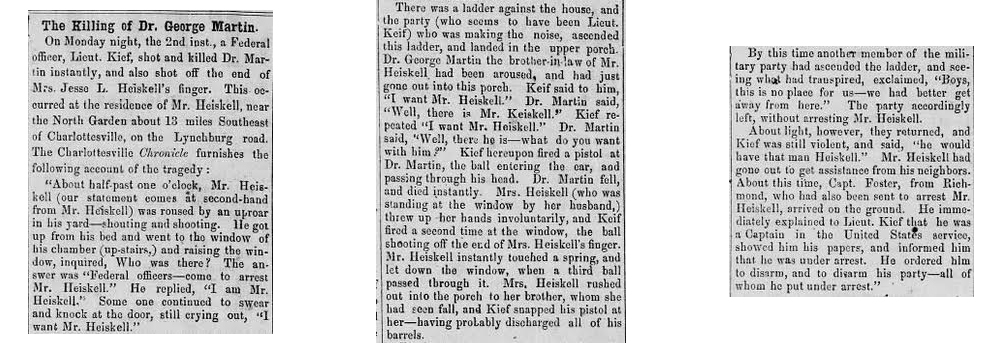
Thomas Keif (or Kief) was a shoemaker, 19 years of age, when he enlisted in Haverhill on 4/16/61 and mustered in to Co. D on 5/1/61. He mustered out 7/31/61. He enlisted again in September, but thought better of walking, enrolling in Co. L of the 1st Mass Cavalry on 9/23/61 as a corporal. The regiment first saw service in early 1862 around Hilton Head, NC. Keif’s company was part of the regiment’s third battalion, which remained behind when the other two battalions went to Virginia and served independently at Beaufort, Hilton Head, Folly Island and Morris Island, as well at the expedition to St. John’s River, Florida. For a while designated the Independent Battalion Mass. Cavalry, they were redesignated the 4th Mass. Cavalry. Kief reenlisted as a veteran as of 1/1/64 and was with the battalion redesignated the 4th Mass Cavalry on 2/12/64. He was promoted sergeant 7/1/64, 1st Sergeant 3/13/65, 2nd Lieutenant on 4/6/65, and commissioned 1st Lieutenant 7/13/65, but not mustered. The regiment lost 4 officers and 22 enlisted men killed or mortally wounded during its service. It took part in various expeditions in South Carolina and Florida. Starting in May 1864 parts of the regiment started moving north to join the Army of the James, some becoming part of the 10th Corps and a few being detached to the 24th and 25th. Company L was one of three companies at the Headquarters of the Army of the James that were ordered to hold High Bridge over the Appomattox River. On April 6, 1865, numbering just 13 officers and 67 men, they were almost annihilated. 8 of the officers were killed or wounded, and Kief’s date of promotion to 2nd Lieutenant indicates he was being promoted to replace one of those officers.
The end of the war, however, was only the beginning of his problems. While on occupation duty in Virginia he was ordered to take a detail of five men and arrest one Colonel J.L. Heiskill at Cole’s Station, Virginia. No particular reasons are given in the records for the arrest or information about Heiskill. In any case, Keif found him at the house of his brother-in-law, Dr. George Martin early in the morning of October 3, 1865. The arrest did not go smoothly. Keif ended up shooting Martin, and was arrested for murder in Charlottesville and confined in prison in Richmond. The charge was that he, “did willfully and maliciously kill Dr. George Martin,” a citizen of Albermarle County, Va, “by shooting him through the head with a revolver,” at the residence of Mr. Jesse L. Heiskill of Nelson County on October 3, 1865. Witnesses included several members of the 4th Mass Cavalry, the 67th Ohio, some civilians, a member of the 24th Mass, and “Jim, Colored Boy.”
A southern newspaper reported that when Keif and his detail arrived at the house, “The inmates of the house, among whom was Dr. Martin, Mr. Heiskill’s brother in law, not opening the door instantly to Keif, the latter, who had procured liquor and become intoxicated on his trip, climbed up to the second story of the front porch of the building, and there shot and killed Dr. Martin, who had stepped out into the porch to ascertain who was applying for admittance. Keif haing killed Dr. Martin, fired the remaining charges into the house, one of the bullets seriously wounding Mrs. Heiskill in the hand, and then left.”
While some officers characterized the matter as “complicated,” General Carroll characterized it as a, “wanton murder committed while in a drunken rage.” It was also thought a good idea to reassure the local population that they would be safe under military rule. In any case, Keif was convicted of second degree murder, sentenced to be dismissed from the service and serve 20 years in prison. He was dismissed 11/20/65 and transported to Clinton Prison in New York, at Dannemora to serve his sentence. We lose track of him shortly after, but there are plenty of opportunities for further research. A quick check notes a Thomas Keif being accused of burglary in Michigan in 1889. It’s possibly the same man, pursuing a new line of work, all the result of a military assignment gone very wrong. $1000.00 less 10%
Call us @ 419-842-1863
*14* VAN BUREN HOYT D 5th REG
Records list him as Hoyt VanBuren. He was 30 years old, from Haverhill and enlisted as a corporal, mustering into Co. D on 5/1/61, as did everyone else, so great was the rush to get to Washington and defend the nation’s capital. His service covers the First Bull Run Campaign and he mustered out with the regiment 7/31/61. $295.00 less 10%
Call us @ 419-842-1863
*17* MATHEW N. GREENLEAF PRVT D 5th REG
Greenleaf was from Exeter, NH, but had been born in Haverhill and seems to have decided to join his old friends, enlisting 4/16/61 and mustering in to Co. D as a private on 5/1/61. He mustered out with the regiment 7/31/61 and then enlisted again, this time mustering into Co. D of the 6th New Hampshire on 11/27/61 as their First Sergeant. The unit was part of Burnside’s Coastal Expedition and became part of his Ninth Corps, taking heavy casualties at Second Bull Run, and seeing action at Antietam and Fredericksburg. It then served in the west until called back for eastern service in Grant’s 1864 Overland Campaign against Richmond. Greenleaf served a full three years, making 2nd Lt. 4/29/62, 1st Lt. 9/12/62, transferring to Co. E, and then being promoted to Captain of Co. H as of 7/1/63. He was wounded at Petersburg 7/30/64 and mustered out for disability on 11/28/64, but was re-commissioned back in Co. C on 3/1/65 and served with them until muster out on 7/17/65. $375.00 sale pending
Call us @ 419-842-1863
*18* CHARLES E. MILLS PRVT D 5th REG
Mills was listed as a resident of Bradford when he enlisted on 4/16/61 and mustered into Co. D as a private on 5/1/61. He was 18 and a shoemaker by profession. He mustered out with the regiment 7/31/61 and signed into Co. D of the 17th Mass on 2/20/62. The regiment was sent to the Carolina coast and posted at New Bern, taking part in a number of expeditions, such as the relief of Little Washington and engagements such as Blount’s Creek and Batchelder’s Creek. He was wounded in action at Goldsboro, NC, on 12/17/62 and promoted to Corporal on 4/3/63. He mustered out 2/19/65. His residence in the 17th was listed as Haverhill, so he must have had some earlier connection with the town. $375.00 less 10%
Call us @ 419-842-1863
*20*DANIEL J. HAYNES CORPL D 5th REG
Haynes was one of the vets of the 5th who later saw service in the 22nd Mass. As with most of Co. D, he was a resident of Haverhill. He was 30 years old and a cordwainer. His age may have given him some authority. He enlisted as a corporal on 4/16/61 and mustered into co. D on 5/61/mustering out 7/31/61. He then mustered into Co. H of the 22nd Mass on 9/6/61. He experience in the 5th apparently counted for something. He mustered in as a sergeant and made First Sergeant on or about 1/1/62. He was one of those taken prisoner when the regiment was decimated at Gaines’ Mill on the Peninsula 6/27/62, but returned to the regiment and was promoted Second Lieutenant 9/6/62. He did not live to be mustered in at the rank, however, dying of disease on 9/29/62 at Fortress Monroe. $325.00 less 10%
Call us @ 419-842-1863
*22* ALBERT H. GOULD PRVT D 5th REG
Gould was from Haverhill and enlisted 4/16/61 and mustered in to Co. D as private 5/1/61, the muster only taking place after the regiment had reached Washington. His service covers First Bull Run, and he mustered out with the regiment 7/31/61 at Boston.
$295.00 less 10%
Call us @ 419-842-1863
*23* GEORGE M. WARREN PRVT B 4th REG
George M. Warren served in the 4th Massachusetts, enlisting 4/16/61 and mustering into Co. B of the 4th Mass. as a private on 4/22/61. He was 20 years old and a teamster from Stoughton, Mass. The regiment was the first to leave the state after Fort Sumter, heading for Fortress Monroe on the afternoon of April 17. They saw action at Big Bethel on June 10, 1861, losing 1 killed and 1 wounded in what some regard as the first engagement of the war.
Warren mustered out 7/22/61 at Long Island in Boston Harbor. He signed up again in 1864, mustering in to the 11th Mass. Light Artillery on 1/2/64. The battery spend the opening of 1864 in Washington as part of the 22nd Corps, but in April was made part of the 9th Army Corps for Grant’s Overland Campaign. They saw action at Wilderness, Spottsylvania and Petersburg, being part of the time detached to the 5th Army Corps, and were credited with 3 enlisted men killed or mortally wounded. Warren survived to muster out 6/16/65. $350.00 less 10%
Call us @ 419-842-1863
Layaways are Welcome
Need to split your order into multiple payments? No problem! A simple 20% earnest money deposit will hold your item for you.-acf
You can then pay it off in easy installments that fit your budget.
Read Terms Here
Items to Sell? Contact Us
I am always interested in buying ANYTHING from the American Civil War… Guns, Swords, Civil War Muskets, Knives, Uniforms, Flags, Medals, Badges, Diaries, Letters, Autographs, Buttons, photographs, tintypes, daguerreotypes, Insignia, Camp Items, Battlefield Relics, canteens, Drums, Etc… Call 419-842-1863 and ask for Dave Taylor.

